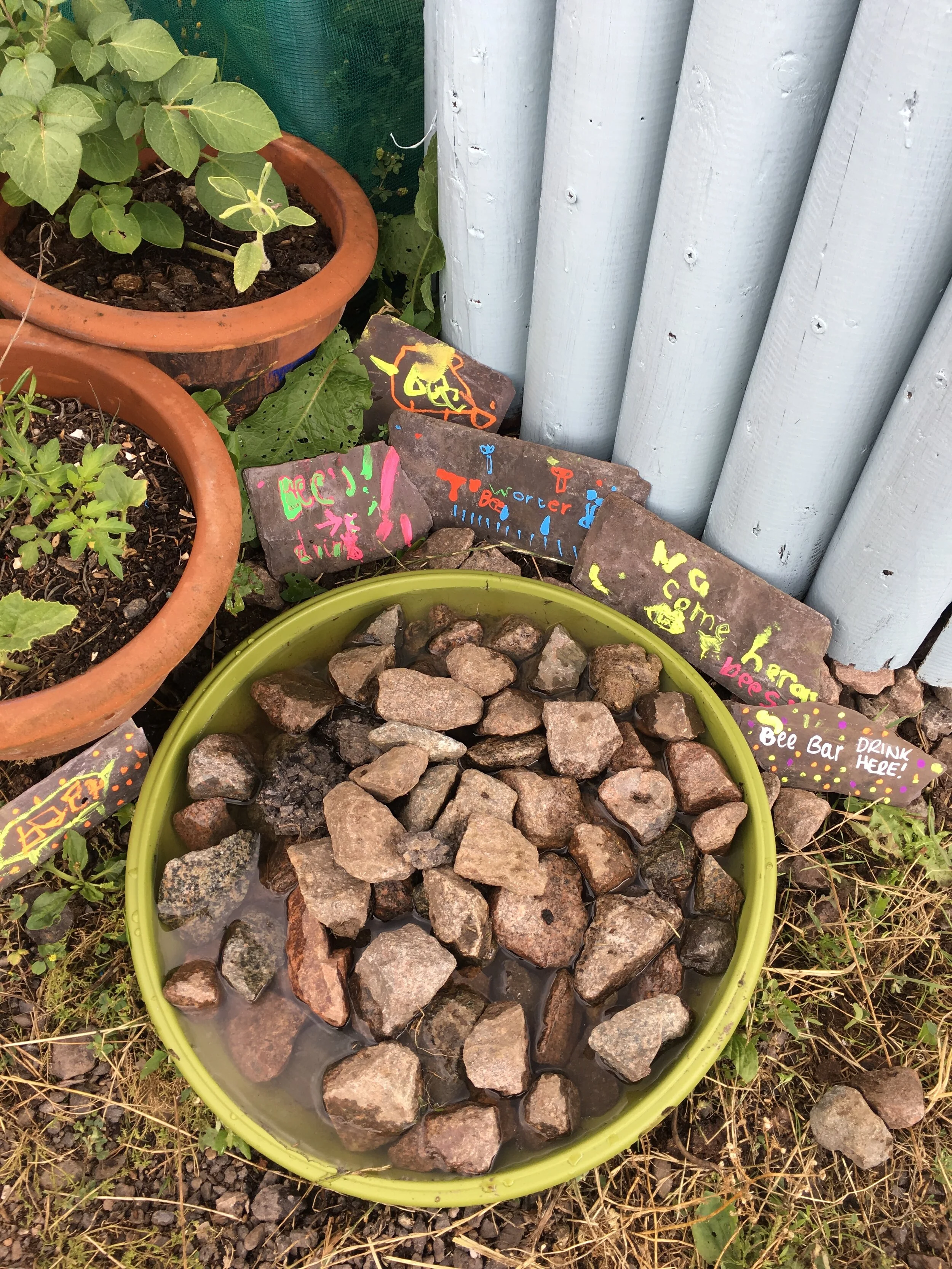How to be a Bee Guardian
A guide to saving the bees.
🐝🐝🐝
Plant flowers
A single hive can house between 40,000-60,000 honeybees, that’s a lot of mouths to feed! Just one hive will need up to 50kg pollen and 250kg nectar to survive, and more to produce excess honey. With the rise in urban beekeeping, there is a lot of competition for forage, leaving bumblebees and solitary bees having to compete for food alongside the often harder working honeybee. The most important action we can do for all bees is to plant bee friendly pollen rich flowers and trees, wherever you are. Take a look at the RHS Plants for Pollinators for extensive bee friendly plant lists. In the UK, plant nurseries will also have bee friendly plants marked with the RHS bee symbol. Try planting a combination of bulbs, herbs, wildflowers, vegetables and pollen rich flowers in your garden to feed the bees throughout the year.
Provide water
A water collecting honeybee can make up to 50 trips to a water source per day and collect around 25mg of water during each visit. A honeybee hive maintains a temperature of 35°C, so they will bring water into the brood to keep the temperature and humidity just right. Honeybees also mix water with pollen to feed their young. Put rocks on the edge of your pond or create a bee drinking station using a plant pot saucer and rocks (see photo to the left)
Learn about bees
Did you know there are over 260 different kinds of solitary bee in the UK alone? There are many different kinds of wild bees and bumblebees, not just honeybees! Learn how to identify which bees are in your back garden or local neighbourhood, and what you can provide for them to help them thrive. Explore our website and blog for more resources - we also recommend the Bumblebee Conservation Trust and Girl Next Door Honey.
Support regenerative farmers
Many small and local farmers work hard to provide nutrient dense food without chemicals and fertilisers that may damage soil health, bee health and other pollinating insect health. If you can’t find a local organic farm, CSA or veg box provider, try Riverford Organic Farmers co-operative who deliver nationwide.
Grow a bit wild
Leave a portion of your lawn slightly overgrown with longer grasses, dandelions and other ‘weeds’ or wildflowers as a space for bees to forage.
Stop using agrochemicals
Pesticides, mostly insecticides, are extremely toxic to honeybees (and all bees!). From a beekeeper’s perspective, watching your honeybees die from pesticide poisoning is heartbreaking. Honeybees become visibly disorientated, agitated, struggle for breath, lose the ability to use their wings and retract their tongue, and will usually die outside of the hive entrance paralysed. Please reconsider spraying chemicals such as RoundUp in your back garden. Can a plant or roots be dug out instead? Are dandelions really weeds? Did you know they are an important food source for over 90 insects including pollinators? Maybe you can use ‘natural’ pesticides such as chilli water or herbicides such as vinegar or salt instead. Care for your garden a bit differently and watch biodiversity flourish! This principle also applies to the seeds which you buy. Some seeds may be treated with chemicals to make them resistant to various diseases or other plant health issues. Always buy your seeds from a ‘real seed’ supplier such as The Real Seed Company, Vital Seeds, or find your local seed library. We have one in Nottingham.
Get Composting
Healthy soil, healthy flowers, healthy bees! Composting our food waste helps reduce greenhouse gas emissions and restores soil. Soil is depleting at a rapid rate across the world, and the UK is said to have enough healthy soil for just 40 more harvests.
Grow your own
Food for bees and for people! Growing flowering bee friendly herbs in pots or windowboxes is super satisfying. Make fresh herbal teas, herb infused oils, herb breads or just liven up your dinner. If you have a bit more space, growing tomatoes or courgettes (which can be done in pots too) are loved by pollinating insects for their bright pollen rich flowers, and provide a glut of produce for your kitchen. Share with your neighbours or try making sugar free tomato jam or courgette fritters with the excess.
Buy local honey
If you have a jar of honey you recently bought from a supermarket, go and look at the label right now! You may find the packaging says a ‘Blend of ‘EU and Non EU honey’. Sometimes it may even say ‘Glucose-Fructose Syrup blended with EU/Non EU honey’. Supporting your local beekeeper or buying honey from smaller retailers such as independent health food shops will usually guarantee your honey is the real deal. This is also the case for Australian and USA honey consumers, who may often find their honey is blended with glucose fructose syrup or has also been imported from China who have different food labelling and production standards. Consuming honey has shown to help with hayfever allergy symptoms, but this only works if you consume local honey which contains the local pollen you may be reacting to. Through buying local honey, supporting local independent retailers and small producers like local beekeepers, you are also helping to transform our food system!
Watch these films
Honeyland, Queen of the Sun, More than Honey & Vanishing of the Bees. Check out the series Rotten on Netflix which has an episode on honey.
Move to a Natural Beekeeping approach
If you already keep honeybees, have you considered a more bee-centric approach? Read up at The Natural Beekeeping Trust to find out more.
How are you working to protect bees and biodiversity? Let us know in the comments.



